Effects of Different Drip Irrigation Rates on Root Distribution Characteristics and Yield of Cotton under Mulch-Free Cultivation in Southern Xinjiang
Abstract
1. Introduction
2. Materials and Methods
2.1. Overview and Management of the Experimental Site
2.2. Experimental Design
2.3. Measurement Items and Methods
2.3.1. Root Index
2.3.2. Yield Index
2.4. Data Processing
3. Results and Analysis
3.1. Effect of Different Irrigation Amounts on Root Growth Characteristics of Filmless Cotton
3.1.1. Effect on RLD
3.1.2. Effect on RSA
3.1.3. Effect on RAD
3.1.4. Effect on RV
3.1.5. Effect on RWD
3.2. Effect of Different Irrigation Amounts on Yield and Yield Components of Filmless Cotton
3.3. Correlation Analysis between Irrigation Amount and Root Index and Yield Index
4. Discussion
5. Conclusions
Author Contributions
Funding
Data Availability Statement
Acknowledgments
Conflicts of Interest
References
- Steadman, J. Cotton’s six biggest challenges for 2023. Cotton Grower 2023, 59, 13. Available online: https://www.proquest.com/trade-journals/cottons-six-biggest-challenges-2023/docview/2818991324/se-2 (accessed on 28 March 2024).
- National Bureau of Statistics. Announcement of the National Bureau of Statistics on Cotton Production in 2023. China Cotton Process. 2023, 15+20. [Google Scholar]
- Lou, S.; Dong, H.; Tian, X.; Tian, L. The “short, dense and early” cultivation of cotton in Xinjiang: History, current situation and prospect. Sci. Agric. Sin. 2021, 54, 720–732. [Google Scholar] [CrossRef]
- Yang, L.; Heng, T.; He, X.; Yang, G.; Zhao, L.; Li, Y.; Xu, Y. Spatial-temporal distribution and accumulation characteristics of residual plastic film in cotton fields in arid oasis area and the effects on soil salt transport and crop growth. Soil Tillage Res. 2023, 231, 105737. [Google Scholar] [CrossRef]
- Zong, R.; Wang, Z.; Li, W.; Li, H.; Ayantobo, O.O. Effects of practicing long-term mulched drip irrigation on soil quality in northwest China. Sci. Total Environ. 2023, 878, 163247. [Google Scholar] [CrossRef] [PubMed]
- Wen, Y.; Liu, J.; Zhang, J.; Li, W.; Ayantobo, O.O.; Wang, Z. Effects of macro-plastics on soil hydrothermal environment, cotton yield, and fiber quality under mulched drip irrigation in the arid region of northwest China. Field Crops Res. 2023, 302, 109060. [Google Scholar] [CrossRef]
- Hu, X.; Chen, H.; Wang, J.; Meng, X.; Chen, F. Effects of soil water content on cotton root growth and distribution under mulched drip Irrigation. Agric. Sci. China 2009, 8, 709–716. [Google Scholar] [CrossRef]
- Li, D.; Li, M.; Shen, X.; Zhou, X.; Sun, H.; Zhao, Y.; Chen, W. Response of spatial structure of cotton root to soil-wetting patterns under mulched drip irrigation. Int. J. Agric. Biol. Eng. 2020, 13, 153–162. [Google Scholar] [CrossRef]
- Chen, W.; Jin, M.; Ferré, T.P.A.; Liu, Y.; Huang, J.; Xian, Y. Soil conditions affect cotton root distribution and cotton yield under mulched drip irrigation. Field Crops Res. 2020, 249, 107743. [Google Scholar] [CrossRef]
- Yu, S. The significance of filmless cotton to promote the transformation and upgrading of China’s cotton industry. J. Agric. 2019, 9, 1–5. [Google Scholar]
- Wang, H.; Cao, H.; Jiang, F.; Wang, X.; Gao, Y. Analysis of soil moisture, temperature, and salinity in cotton field under non-mulched drip irrigation in South Xinjiang. Agriculture 2022, 12, 1589. [Google Scholar] [CrossRef]
- Wang, J.; Du, G.; Tian, J.; Jiang, C.; Zhang, Y.; Zhang, W. Mulched drip irrigation increases cotton yield and water use efficiency via improving fine root plasticity. Agric. Water Manag. 2021, 255, 106992. [Google Scholar] [CrossRef]
- Li, H.; Qi, Z.; Gui, D.; Zeng, F. Water use efficiency and yield responses of cotton to field capacity-based deficit irrigation in an extremely arid area of China. Int. J. Agric. Biol. Eng. 2019, 12, 91–101. [Google Scholar] [CrossRef]
- Allan, R.G.; Pereira, L.S.; Raes, D.; Smith, M. Crop Evapotranspiration. Guidelines for Computing Crop Water Requirements; Irrigation and Drainage; FAO: Rome, Italy, 2004; Volume 56. [Google Scholar]
- Chen, Z.; Ding, D.; Dong, W.; Wang, N.; Li, Y.; Feng, H. Effects of plastic mulching on root growth and yield of winter wheat under different sowing dates. Agric. Res. Arid Areas 2021, 39, 136–145. [Google Scholar]
- Wang, S.; Xue, H.; Zhang, Z.; Tang, J. Coordination of root growth and leaf senescence in cotton. Acta Agron. Sin. 2020, 46, 93–101. [Google Scholar] [CrossRef]
- Zhang, H. Study on Root Characteristics of High Yield Cotton and Its Regulation Technology with Under-Mulch-Drip Irrigation; Shihezi University: Shihezi, China, 2014. [Google Scholar]
- Kumar, R.; Mishra, S.K.; Singh, K.; Al-Ashkar, I.; Iqbal, M.A.; Muhammad, N.M.; Sabagh, A.E. Impact analysis of moisture stress on growth and yield of cotton using DSSAT-CROPGRO-cotton model under semi-arid climate. PeerJ 2023, 11, e16329. [Google Scholar] [CrossRef] [PubMed]
- Wang, L.; Lin, M.; Han, Z.; Han, L.; He, L.; Sun, W. Simulating the effects of drought stress timing and the amount irrigation on cotton yield using the CSM-CROPGRO-cotton model. Agronomy 2024, 14, 14. [Google Scholar] [CrossRef]
- Zhi, X.; Han, Y.; Li, Y.; Wang, G.; Lu, F.; Yang, B.; Mao, S. Root growth and spatial distribution characteristics for seedlings raised in substrate and transplanted cotton. PLoS ONE 2017, 12, e0190032. [Google Scholar] [CrossRef]
- Sampathkumar, T.; Pandian, B.J.; Mahimairaja, S. Soil moisture distribution and root characters as influenced by deficit irrigation through drip system in cotton–maize cropping sequence. Agric. Water Manag. 2012, 103, 43–53. [Google Scholar] [CrossRef]
- Yan, X. Principles and Applications of Root Biology; Science Press: Beijing, China, 2007. [Google Scholar]
- Zhu, W.; Zhao, D.; Di, N.; Li, D.; Zhou, O.; Sun, Y.; Xi, B. Matching root water uptake patterns to fine root and soil water distributions. Plant Soil 2024, 495, 499–516. [Google Scholar] [CrossRef]
- Knipfer, T. Future in the past: Water uptake function of root systems. Plant Soil 2022, 481, 495–500. [Google Scholar] [CrossRef]
- Fang, Y.; Zhao, C.; Chuan, Z.; Sheng, Y.; Lin, Q. Root distribution characteristics of cotton in different drip irrigation amounts irrigation under mulched. J. Soil Water Conserv. 2007, 21, 96–100+200. [Google Scholar]
- Hou, Z.; Li, P.; Lv, X.; Gong, J.; Wang, Y. Distributions of water, salinity, and nitrogen in cotton rootzone by different fertigation strategies. Sci. Agric. Sin. 2007, 40, 549–557. [Google Scholar]
- Yang, R.; Tian, C.; Mai, W. Characteristics of root development in cotton suffering presenility under drip irrigation and film mulch in Xinjiang Autonomous Region. Plant Nutr. Fertil. Sci. 2016, 22, 1384–1392. [Google Scholar] [CrossRef]
- Xin, M.; Wei, H.; Yang, B.; Li, X.; Fan, Z.; Han, Y.; Li, Y.; Yu, S. Application effect of membrane-free cultivation mode on cotton production under machine-picked planting mode in Southern Xinjiang. Xinjiang Agric. Sci. 2021, 58, 1265–1274. [Google Scholar]
- Wang, J.; Du, G.; Tian, J.; Zhang, Y.; Jiang, C.; Zhang, W. Effect of irrigation methods on root growth, root-shoot ratio and yield components of cotton by regulating the growth redundancy of root and shoot. Agric. Water Manag. 2020, 234, 106120. [Google Scholar] [CrossRef]
- Yan, Y.; Zhang, C.; Sheng, Y.; Li, J.; Peng, D.; Li, Z. Effects of drip irrigation under mulching on cotton root and shoot biomass and yield. Chin. J. Appl. Ecol. 2009, 20, 970–976. [Google Scholar]
- Yang, T. Growth Simulation and Yield Evaluation of Membrane-Less Cotton under Different Irrigation Gradient; Tarlim University: Alar, China, 2023. [Google Scholar]
- Luo, H.; Zhang, H.; Tao, X.; Zhang, Y.; Zhang, W. Effect of irrigation and nitrogen application regimes on senescent characters of roots and leaves in cotton with under-mulch-drip irrigation. Sci. Agric. Sin. 2013, 46, 2142–2150. [Google Scholar]
- Li, Z.; Dou, H.; Zhang, W.; He, Z.; Li, S.; Xiang, D.; Zhang, Y. The root system dominates the growth balance between the aboveground and belowground parts of cotton. Crop Environ. 2023, 2, 221–232. [Google Scholar] [CrossRef]
- Yilmaz, E.; Gürbüz, T.; Dağdelen, N.; Wzorek, M. Impacts of different irrigation water levels on the yield, water use efficiency, and fiber quality properties of cotton (Gossypium hirsutum L.) irrigated by drip systems. Euro-Mediterr. J. Environ. Integr. 2021, 6, 53. [Google Scholar] [CrossRef]
- Guo, C.; Bao, X.; Sun, H.; Zhu, L.; Zhang, Y.; Zhang, K.; Bai, Z.; Zhu, J.; Liu, X.; Li, A.; et al. Optimizing root system architecture to improve cotton drought tolerance and minimize yield loss during mild drought stress. Field Crops Res. 2024, 308, 109305. [Google Scholar] [CrossRef]
- Yang, B. The Effects and Its Mechanisms of Deficit Irrigation Quota and Frequency on Cotton Yield Formation and Field Environment in Southern Xinjiang; Huazhong Agricultural University: Wuhan, China, 2023. [Google Scholar]
- Wang, D. Response of Cotton Yield and Water Efficiency to Irrigation Amount and Its Regional Adaptability in Southern Xinjiang; Huazhong Agricultural University: Wuhan, China, 2023. [Google Scholar]
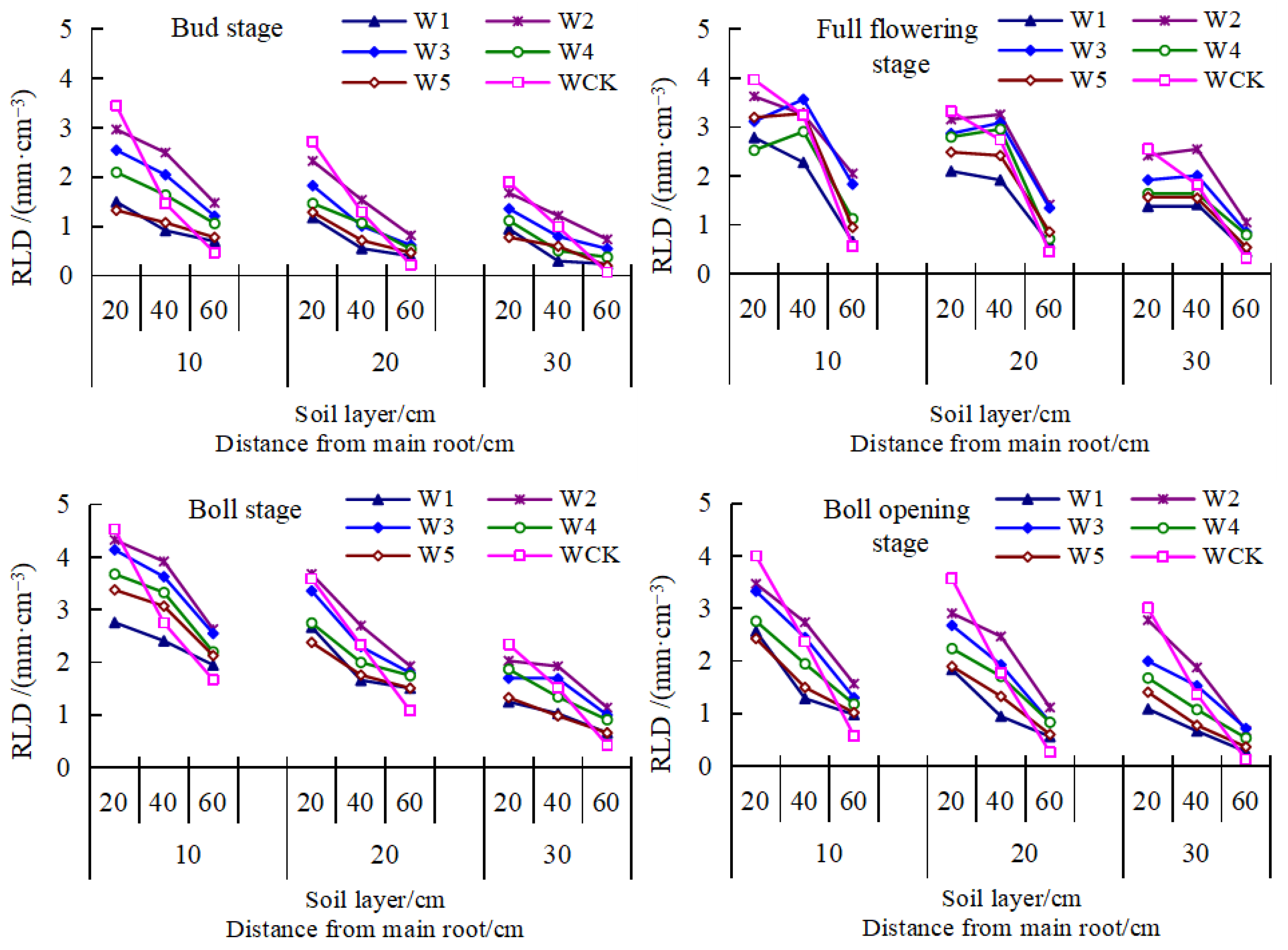


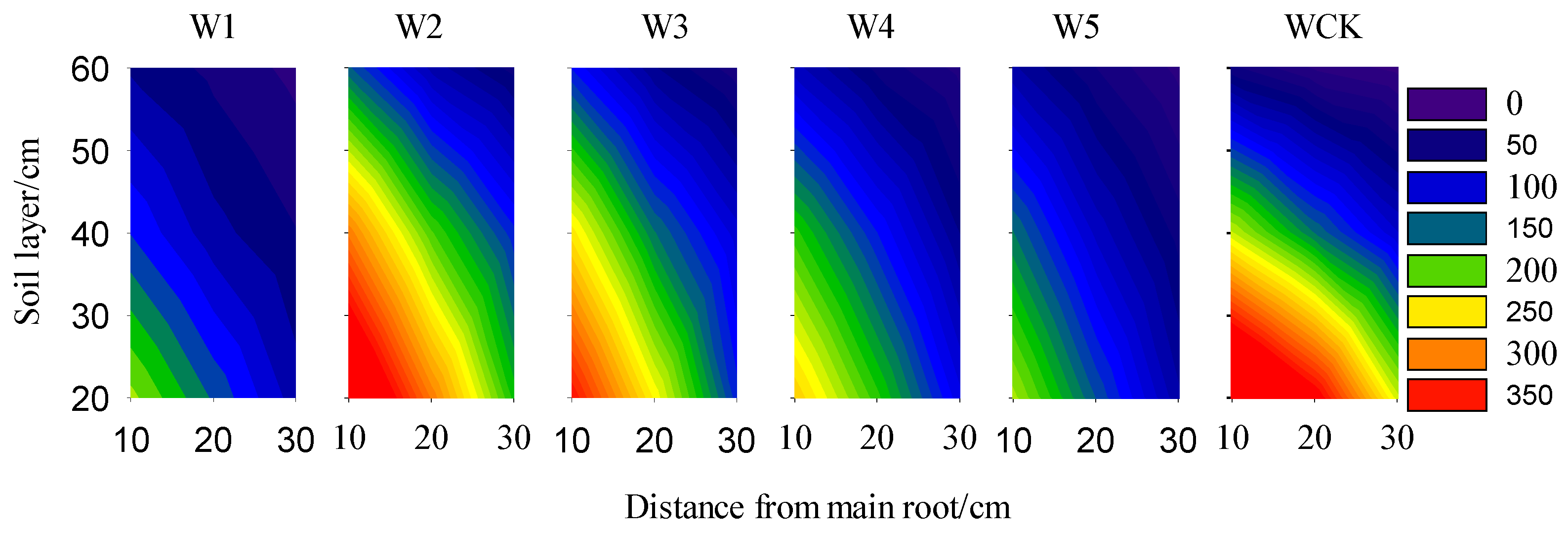
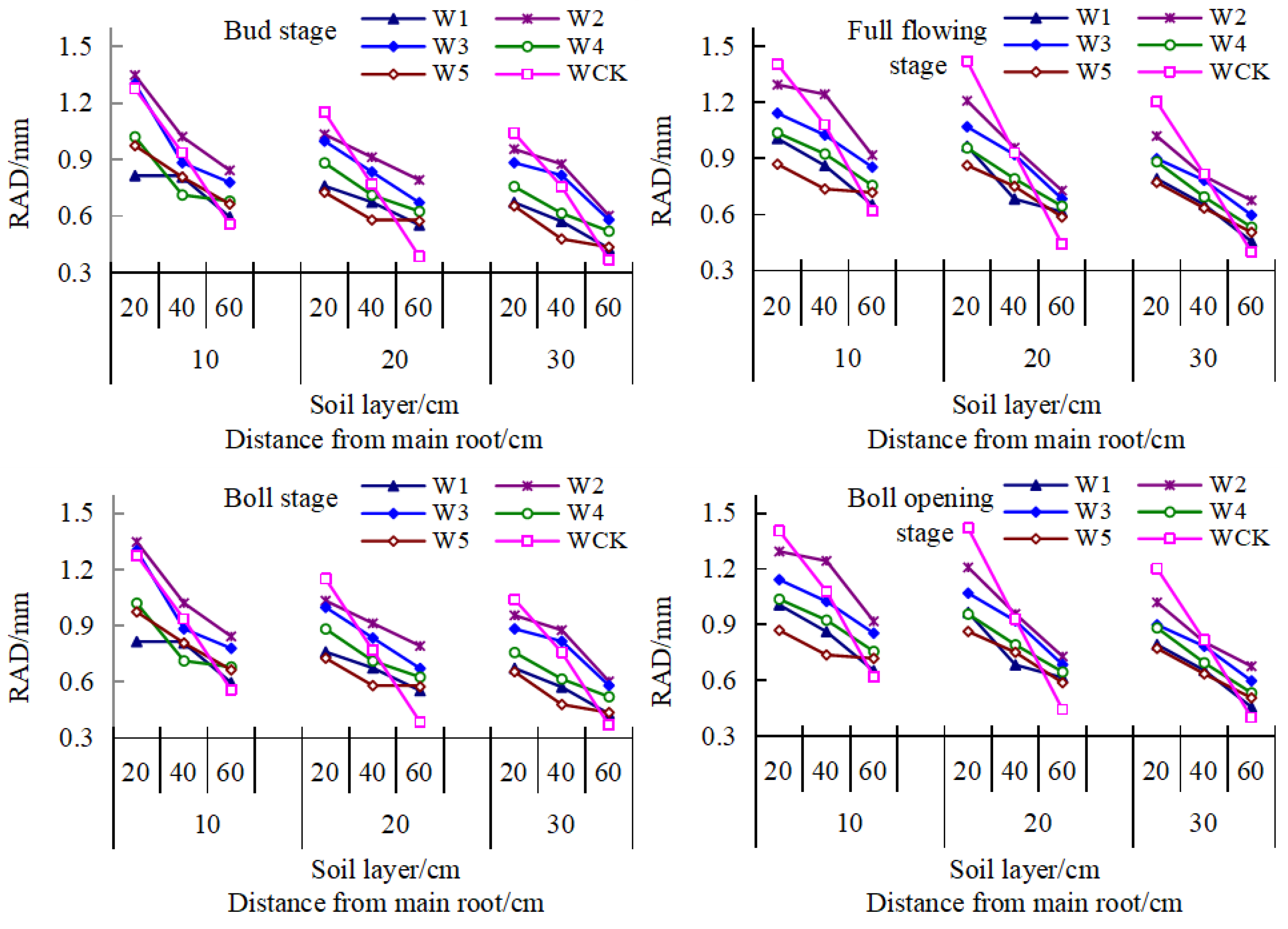
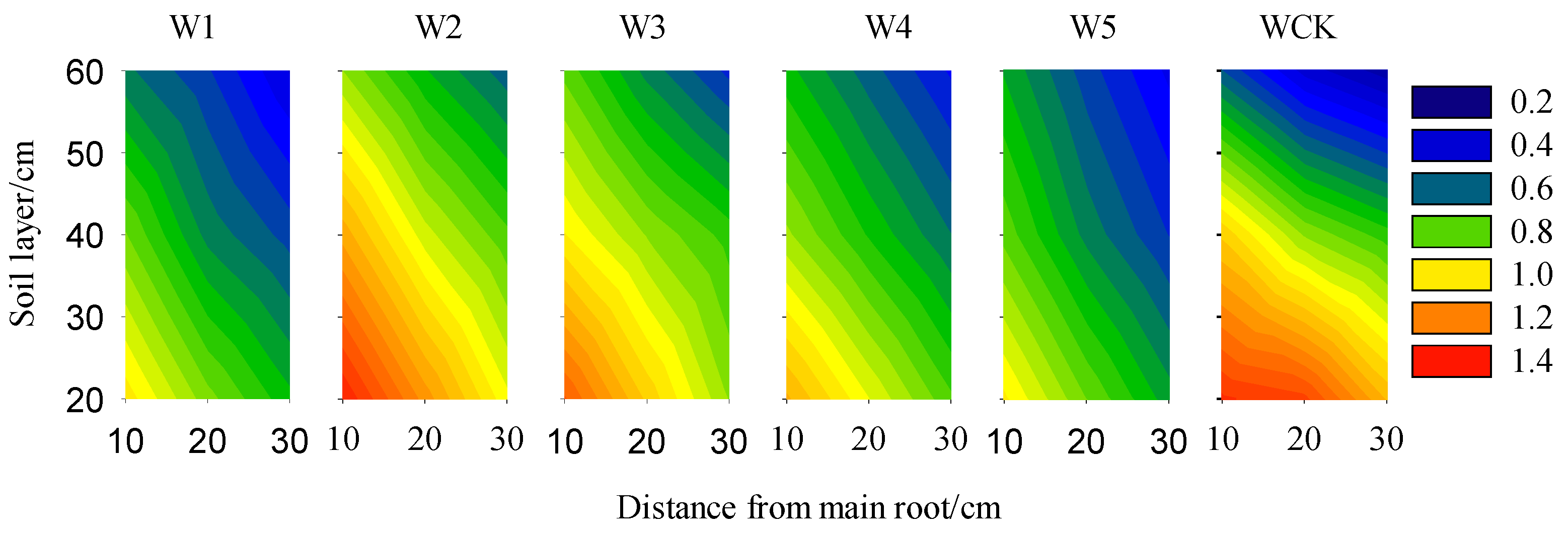
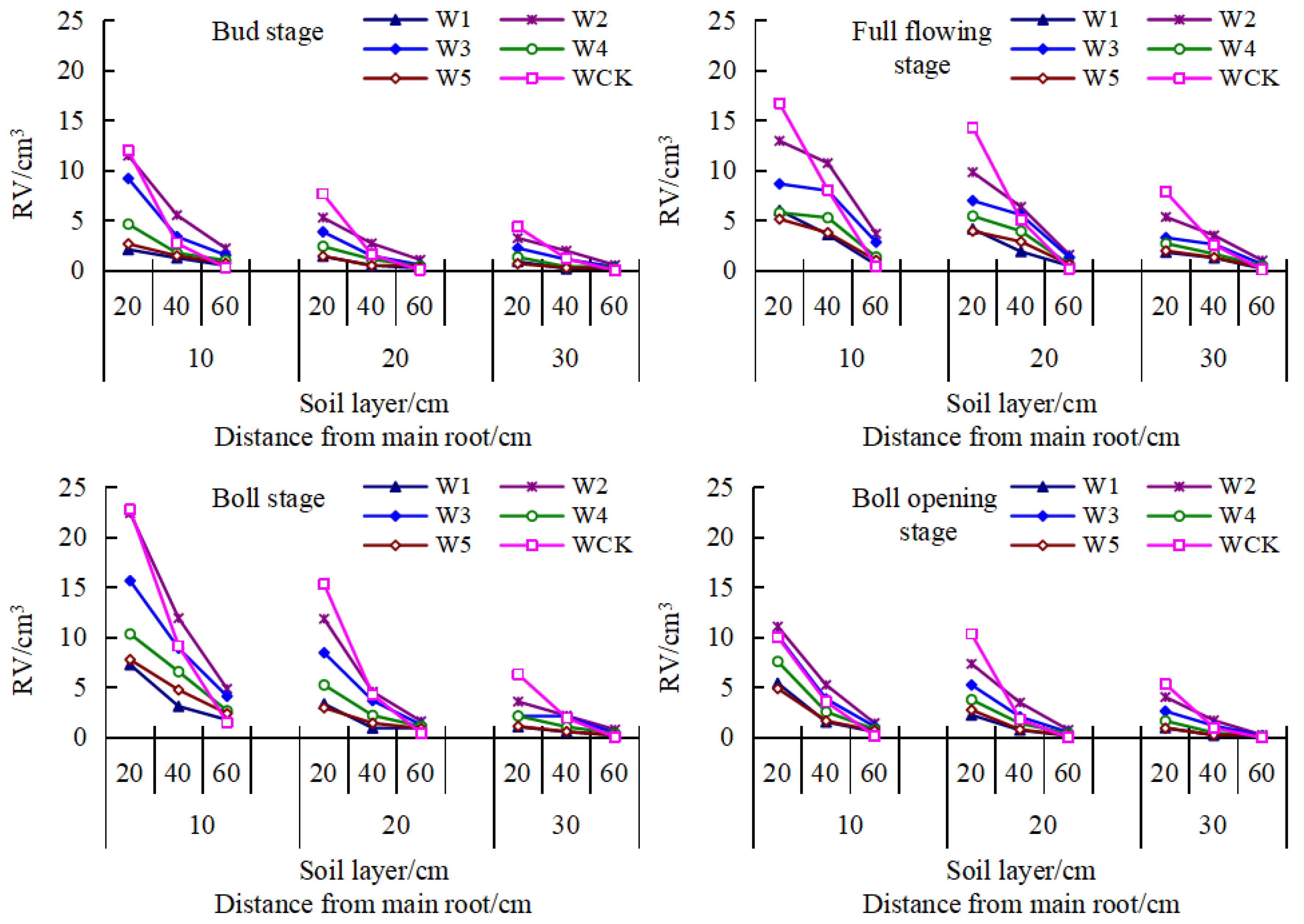

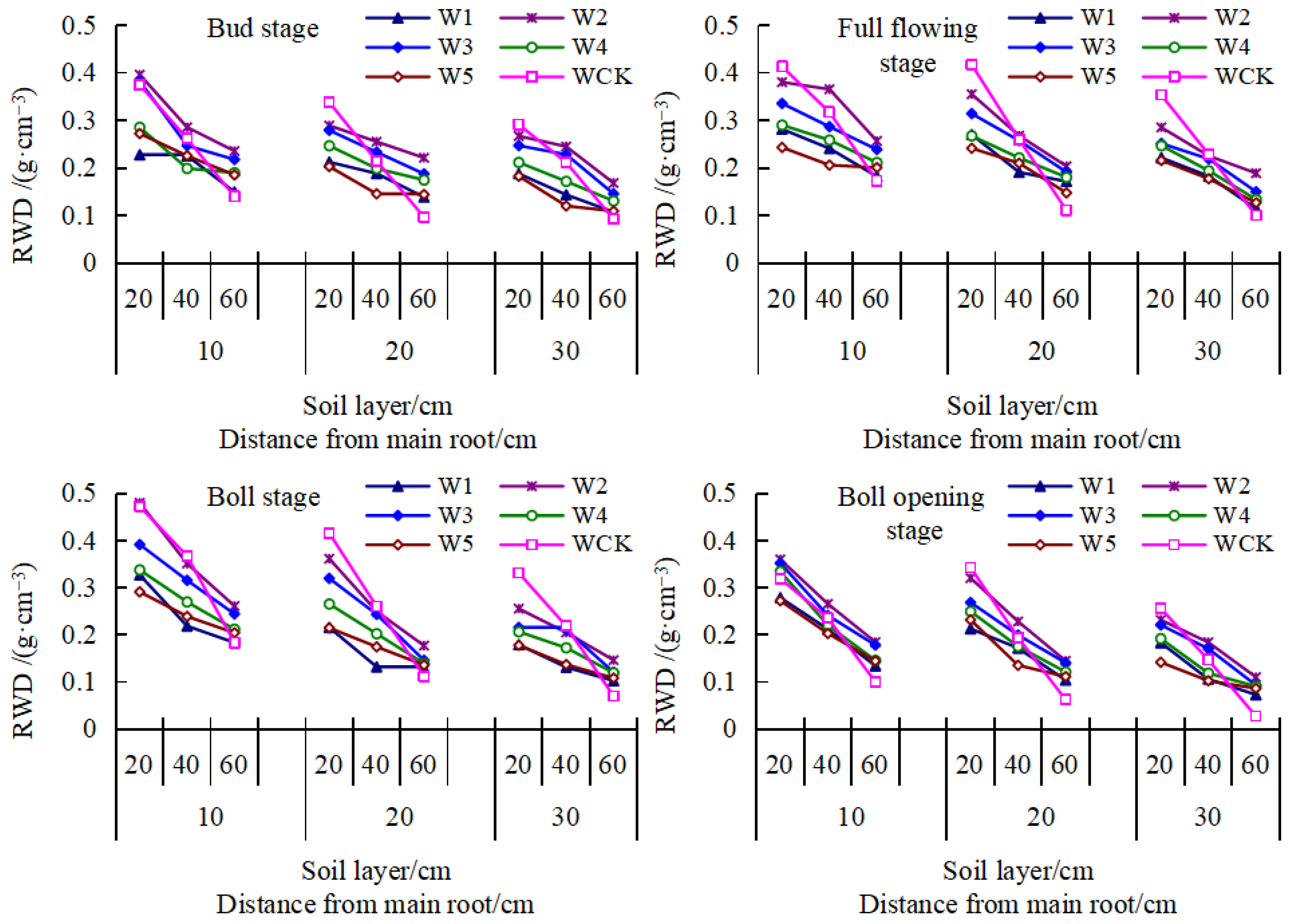


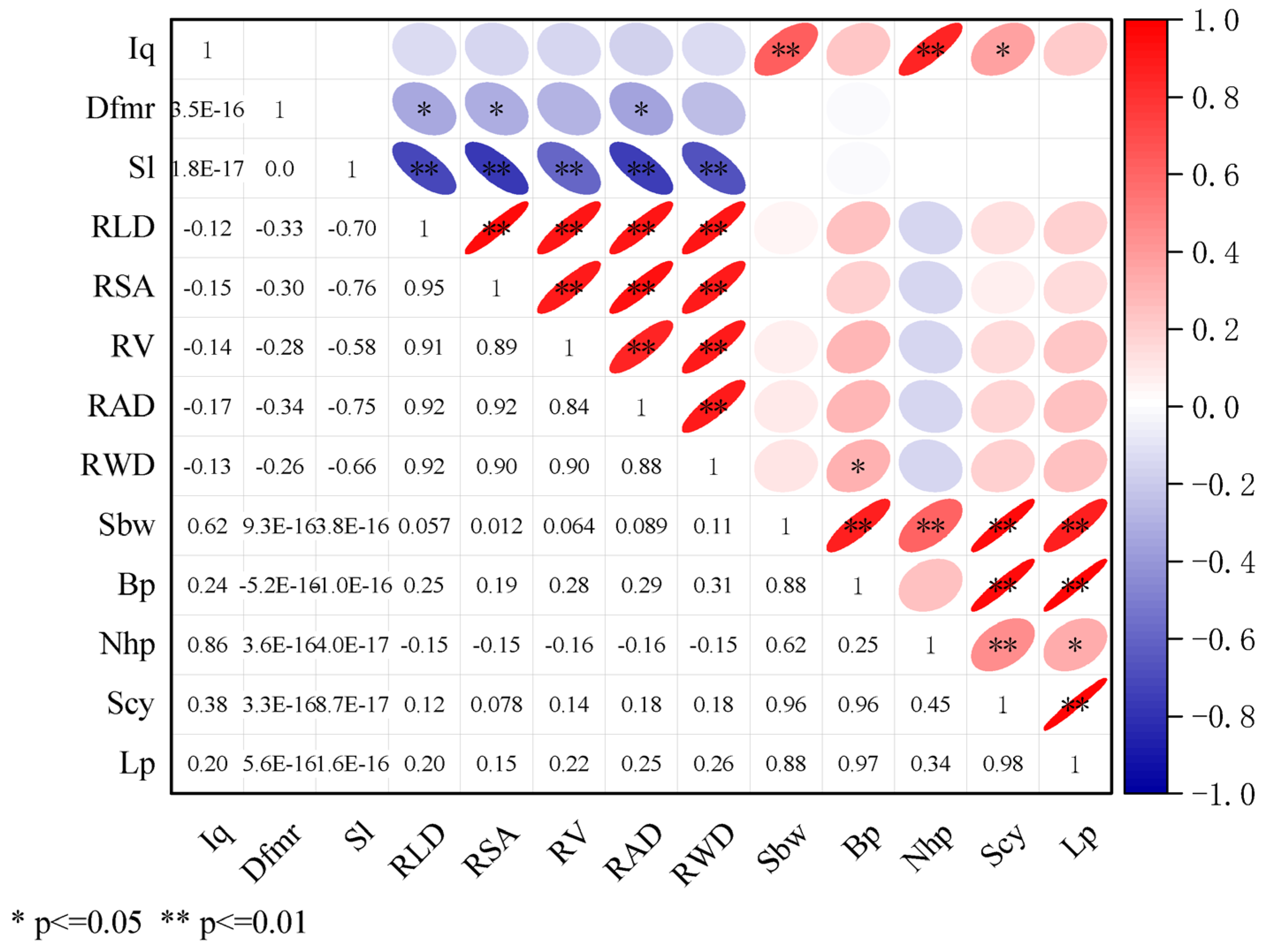
| Year | Month | Average Temperature/°C | Average Relative Humidity/% | Average Pan Evaporation/(mm d−1) | Average Wind Speed/(m·s−1) | Average Sunshine Hours/(h·d−1) | Rainfall/mm | Reference Crop Evapotranspiration ET0/mm |
|---|---|---|---|---|---|---|---|---|
| 2022 | April | 18.3 | 28.5 | 5.9 | 2.6 | 7.1 | 0.0 | 149.3 |
| May | 24.4 | 31.9 | 8.0 | 2.9 | 7.3 | 0.1 | 196.7 | |
| June | 25.3 | 39.4 | 7.6 | 2.3 | 8.5 | 0.4 | 165.4 | |
| July | 26.9 | 44.7 | 7.8 | 2.6 | 7.8 | 17.9 | 172.4 | |
| August | 22.9 | 65.7 | 4.7 | 2.2 | 5.3 | 33.9 | 97.2 | |
| September | 22.2 | 47.1 | 5.7 | 1.8 | 9.2 | 0.0 | 108.0 | |
| October | 11.8 | 48.2 | 3.5 | 1.6 | 7.4 | 0.0 | 48.9 | |
| 2023 | April | 15.3 | 27.5 | 5.4 | 2.5 | 6.1 | 0.0 | 123.1 |
| May | 19.6 | 33.0 | 7.1 | 3.0 | 8.6 | 0.5 | 168.6 | |
| June | 26.8 | 33.7 | 8.4 | 2.5 | 9.6 | 5.2 | 196.7 | |
| July | 27.1 | 44.7 | 7.3 | 2.3 | 7.9 | 4.5 | 162.2 | |
| August | 25.3 | 47.0 | 5.9 | 2.1 | 8.6 | 0.4 | 141.5 | |
| September | 20.4 | 49.4 | 5.5 | 2.0 | 8.9 | 11.9 | 103.1 | |
| October | 13.4 | 48.9 | 3.0 | 1.3 | 8.6 | 0.0 | 45.6 |
| Phenological Phases | Time Ranges/(M/D) | ETC/mm | Water Treatment/mm | |||||||
|---|---|---|---|---|---|---|---|---|---|---|
| 2022 | 2023 | 2022 | 2023 | W1 | W2 | W3 | W4 | W5 | WCK | |
| TLS | 21 April–15 May | 24 April–17 May | 63 | 51 | 30 | 37.5 | 45 | 52.5 | 60 | 45 |
| PBS | 15 May–28 May | 18 May–31 May | 59 | 62 | 30 | 37.5 | 45 | 52.5 | 60 | 45 |
| IBS | 29 May–14 June | 1 June–15 June | 80 | 75 | 30 | 37.5 | 45 | 52.5 | 60 | 45 |
| FBS | 15 June–1 July | 16 June–30 June | 71 | 88 | 36 | 45 | 54 | 63 | 72 | 54 |
| IFS | 2 July–11 July | 1 July–13 July | 74 | 55 | 36 | 45 | 54 | 63 | 72 | 54 |
| FFS | 12 July–24 July | 14 July–26 July | 69 | 87 | 42 | 52.5 | 63 | 73.5 | 84 | 63 |
| LFS | 25 July–4 August | 27 July–6 August | 63 | 59 | 36 | 45 | 54 | 63 | 72 | 54 |
| FBoS | 5 August–18 August | 7 August–21 August | 55 | 76 | 30 | 37.5 | 45 | 52.5 | 60 | 45 |
| FBoS | 19 August–15 September | 22 August–17 September | 61 | 83 | 30 | 37.5 | 45 | 52.5 | 60 | 45 |
| 21 April–15 September | 24 April–17 September | 595 | 636 | 300 | 375 | 450 | 525 | 600 | 450 | |
| Treatment | Single Boll Weight/g | Bolls per Plant | Number of Harvested Plants/(×104·hm−2) | Seed Cotton Yield/(kg·hm−2) | Lint Percentage/% |
|---|---|---|---|---|---|
| W1 | 4.53 ± 0.27 b | 3.91 ± 0.19 d | 17.85 ± 1.16 a | 2901.45 ± 268.25 e | 39.76 ± 1.38 a |
| W2 | 4.61 ± 0.21 b | 4.48 ± 0.27 c | 18.17 ± 1.10 a | 3701.66 ± 170.56 d | 39.86 ± 1.79 a |
| W3 | 5.06 ± 0.25 a | 5.07 ± 0.25 b | 19.09 ± 0.85 a | 4833.25 ± 237.14 b | 41.03 ± 1.62 a |
| W4 | 5.04 ± 0.22 a | 4.66 ± 0.13 c | 19.72 ± 1.02 a | 4589.14 ± 246.06 bc | 40.61 ± 1.70 a |
| W5 | 5.04 ± 0.23 a | 4.53 ± 0.12 c | 19.14 ± 1.23 a | 4303.34 ± 166.27 c | 40.02 ± 1.07 a |
| WCK | 5.13 ± 0.14 a | 6.77 ± 0.33 a | 19.67 ± 0.99 a | 6693.25 ± 211.28 a | 41.62 ± 1.71 a |
Disclaimer/Publisher’s Note: The statements, opinions and data contained in all publications are solely those of the individual author(s) and contributor(s) and not of MDPI and/or the editor(s). MDPI and/or the editor(s) disclaim responsibility for any injury to people or property resulting from any ideas, methods, instructions or products referred to in the content. |
© 2024 by the authors. Licensee MDPI, Basel, Switzerland. This article is an open access article distributed under the terms and conditions of the Creative Commons Attribution (CC BY) license (https://creativecommons.org/licenses/by/4.0/).
Share and Cite
Wan, Y.; Li, W.; Wang, J.; Wu, B.; Su, F. Effects of Different Drip Irrigation Rates on Root Distribution Characteristics and Yield of Cotton under Mulch-Free Cultivation in Southern Xinjiang. Water 2024, 16, 1148. https://doi.org/10.3390/w16081148
Wan Y, Li W, Wang J, Wu B, Su F. Effects of Different Drip Irrigation Rates on Root Distribution Characteristics and Yield of Cotton under Mulch-Free Cultivation in Southern Xinjiang. Water. 2024; 16(8):1148. https://doi.org/10.3390/w16081148
Chicago/Turabian StyleWan, Yanan, Wenjun Li, Jichuan Wang, Bingrong Wu, and Feiyan Su. 2024. "Effects of Different Drip Irrigation Rates on Root Distribution Characteristics and Yield of Cotton under Mulch-Free Cultivation in Southern Xinjiang" Water 16, no. 8: 1148. https://doi.org/10.3390/w16081148
APA StyleWan, Y., Li, W., Wang, J., Wu, B., & Su, F. (2024). Effects of Different Drip Irrigation Rates on Root Distribution Characteristics and Yield of Cotton under Mulch-Free Cultivation in Southern Xinjiang. Water, 16(8), 1148. https://doi.org/10.3390/w16081148





